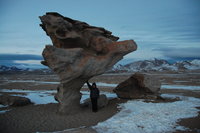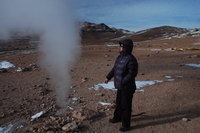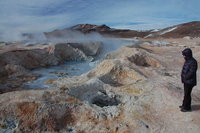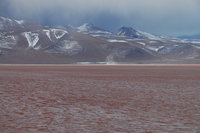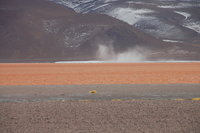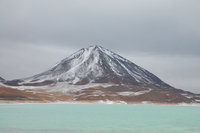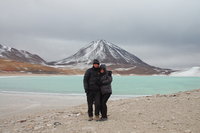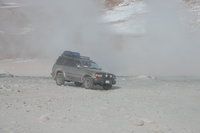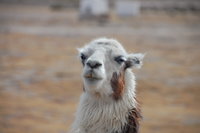
The bus trip from Potosi to Uyuni passed without incident (other than us spotting our first llamas by the wayside). We did end up driving through a sand storm that reduced visibility (but not speed) to almost zero, but we arrived in Uyuni safely and on time. The town itself is a wind battered, sand blasted, bitterly cold hell-hole at the absolute epicentre of nowhere, 3668m above sea level. It used to be the junction of a number of railway lines and was Bolivia's connection with the outside world. Now it isn't. True to form, the wind was howling and sand was flying down the deserted streets as we trudged through town looking for accommodation. Upon checking in to our hostal, we were told there was currently no internet access (quelle horreur!). This turned out to be rather an understatement; actually the entire town was without power of any sort. Something to do with the wind apparently! However, we were undeterred and the next morning we were picked up by Elvis, a local from Uyuni who was to be our driver and guide for the next three days as we explored the Salar de Uyuni and the Eduardo Avaroa National Park. Elvis had no English to speak of so all communication was in Spanish which is OK if you know the Spanish word for "salt"...
The Salar de Uyuni is a 9000 square km salt lake (the world's largest) that was a 70m deep lake in on the southern Altiplano until 12000 years ago. It is now a flat salt pan stretching to the horizon in all directions and is up to 120m deep. Temperatures here can range from 30°C during the day to -30°C at night which represents the largest daily temperature range in the world. It also makes for some interesting nights as most accommodation has no heating.
Since we were here in the dry season, it was possible to drive across the hard salt crust. Elvis took us out on to the salt flats where we drove for hours towards the distant volcanoes without them seeming to get any nearer. We visited strange islands in the salt populated with cactus and marvelled at the interminable white flatness of the Salar. We spent the night in a hotel constructed entirely of salt blocks nestling at the foot of the Tahua volcano at the northern extremity of the Salar (which did have heating).
It is hard to describe the majesty of the Salar de Uyuni. There is actually very little there, but the sheer weirdness of the environment makes it something rather special and unique. We had visited a salt lake in the Etosha National Park in Namibia, but this is salt on a much larger scale. Rather than trying to describe further, here are a few snaps of the place.
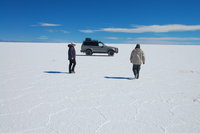
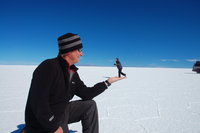
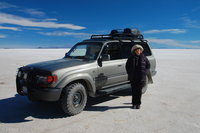
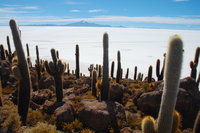
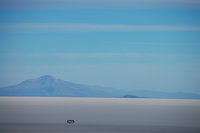
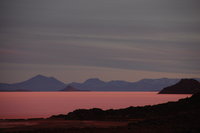
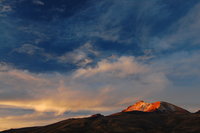
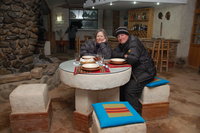
After visiting the salt flats, we travelled south to the extreme bottom left hand corner of Bolivia where it borders Argentina and Chile. This is the Eduardo Avaroa National Park, high in the Andes. The park is some 7147 square km and it ranges in altitude from 4000m to 6000m. It also contains Bolivia's only active volcano (at the moment) called Ollague.
It is quite a drive from the Salar to the Park and it took most of a day along gravel and dirt roads. We passed strange, wind-eroded formations and lakes populated with rare flamingos as we climbed higher into the mountains. Eventually, as the sun began to drop behind the mountains, we entered El Paso del Inca which is a high mountain pass the Incas used when crossing the mountains (on foot of course). The Land Cruiser made a valiant effort at navigating the pass which was lined with snow and ice since it receives no sun. Eventually however, we became completely bogged down and unable to proceed. We had paid a little more for a better quality tour company so Elvis came equipped with a shovel! Eventually we dug our way out and carried on. Elvis was a little more cautious now! As a result, when we next came to a large amount of snow, we decided to take a slightly different route. Soon, we crested a brow on the gravel as the sun went down only to find another 4x4 with only 3 wheels on (3x3 ?) and its rather cold passengers waving frantically. They had a flat tyre and, whilst they had a spare, they had no jack! A less expensive tour we presume. They had managed to get the old wheel off and now the vehicle lay at a jaunty angle in the gravel. Elvis came equipped with a jack too and we soon had a set of very annoyed people on their way. We might even have saved some lives as a night out with no equipment at that altitude and temperature would not have been pleasant. Feeling suitably righteous, we soon arrived at our hotel in the park only to find they had no diesel, so there was no electricity and that the heating would only be on for about 3 hours in the evening. Megan was most pleased.
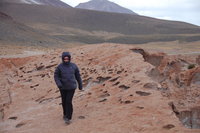
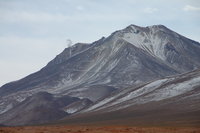
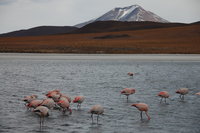
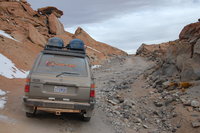
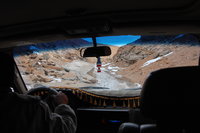
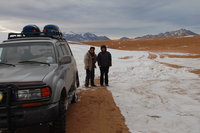
We had been picking up reports along the way that parts of the park were inaccessible due to high winds and driving snow, so there was a question as to how far into the park we would be able to get. Our final destination was Laguna Verde (Green Lake) at the extreme southern end of the park near the Chilean border. After a rather chilly night with no heating, we made a 6am start in convoy with another vehicle to see how far into the park we could get.
The hotel we had stayed in had felt in the middle of nowhere, but driving through the park made us feel truly remote. The landscape is deeply inhospitable and at the same time incredibly beautiful. It seems to have barely changed since the Incas passed through in search of new lands. We passed the so called Salvador Dali desert and the Geiser Sol de Mañana thermal vents spraying out superheated steam that froze in the frigid atmosphere before it hit the ground. At one point, the landscape became reminiscent of Rotorua in New Zealand with its bubbling mud pools. The difference here was that there were no safety fences to stop you falling in!
We came to an amazing red lake known as the Laguna Colorada. It changes hue and intensity during the day as the wind churns up the Dunaliella salina bacteria (so we're told). Here we saw even more of the rare Andean flamingos. Since we were travelling in tandem, we decided to push on to try and achieve our final objective of the Laguna Verde. As it turned out, the journey was not too bad, perhaps the wind had blown all the snow away. Eventually, we crested a ridge and spotted the incredible green lake with the Licancabur volcano as a backdrop. Quite a spectacular setting and (we felt) quite an achievement to get there.
It was a long trek back from Laguna Verde to Uyuni - probably 8 hours of gravel roads from the inhospitable high desert to the equally inhospitable Uyuni. Still, we knew we had a flight out first thing the next morning to the highest international airport in the world in the Bolivian capital of La Paz.
